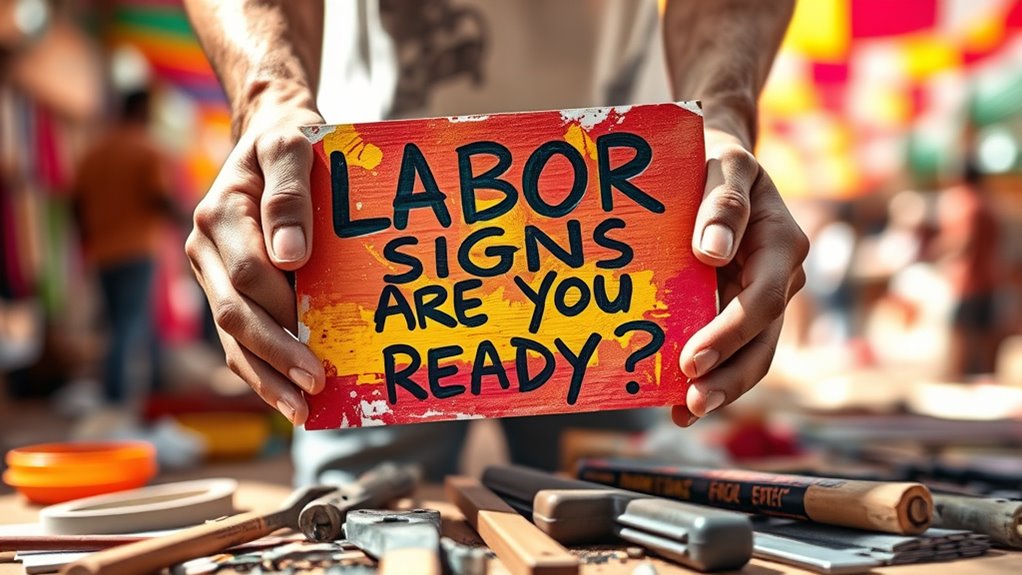As you prepare for childbirth, it’s essential to recognize the signs of labor. Pay attention to strong, regular contractions that don’t fade when you change positions. You might notice increased pelvic pressure or experience a bloody show. Keep track of contraction timing, as true labor usually involves contractions every 5 to 10 minutes. Staying hydrated and having a birth plan can help. Ready to learn more about these signs and what to expect?
Key Takeaways
- Strong, frequent contractions that don’t stop with position changes may indicate you are in early labor.
- A bloody show or loss of the mucus plug suggests your body is preparing for childbirth.
- If your water breaks, whether as a gush or trickle, it’s a sign to seek medical attention.
- Regular contractions occurring every 5 to 10 minutes signal that it’s time to head to the hospital.
- Staying hydrated and having a birth plan can help you feel more prepared for labor.

Labor signs are crucial indicators that your body is preparing for childbirth. Understanding these signs can help you feel more in control as you approach this significant moment. The labor process involves uterine contractions and cervical dilation, culminating in the delivery of your baby. It can start differently for each pregnancy], so it’s essential to familiarize yourself with what to expect.
One of the first signs that labor is approaching is when your baby drops into your pelvis. This can increase pressure on your bladder, making you feel like you need to urinate more frequently. As labor nears, you’ll notice your cervix beginning to dilate, and you may experience cramps or increased back pain. Hormonal changes could even lead to diarrhea, which is your body’s way of preparing for labor. You might feel fatigued and experience a nesting instinct, wanting to organize your space for the new arrival.
As you move into early labor, you’ll notice strong, frequent contractions that don’t ease up with position changes. This is a sign that your body is in action. You may also see a bloody show or lose your mucus plug, which is an indication that your body is getting ready. Waters breaking can happen as a gush or a trickle, and you might feel cramping similar to strong menstrual cramps, accompanied by increased pressure in your lower abdomen. Regular contractions occurring every 5 to 10 minutes can also indicate that you are in true labor.
Be aware of false labor signs, too. If contractions are irregular or weak, or they only occur in the lower uterus, you mightn’t be in true labor. These contractions often stop when you change positions or drink fluids, and they typically don’t lead to cervical dilation. Braxton Hicks contractions are a common occurrence and can confuse you, but they’re not a sign of labor.
Timing and frequency of contractions are key in determining when to seek medical attention. In early labor, contractions may be spaced around 20 minutes apart and last from 30 to 45 seconds each. Keep track of their timing from start to start, as this will help you gauge your progress.
Preparing for labor means recognizing these early signs and staying hydrated. It’s beneficial to move around during early labor and have a birth plan in place. Knowing when to head to the hospital and following your healthcare provider’s advice will set you up for a smoother experience as you welcome your little one into the world.
Frequently Asked Questions
What Should I Pack for the Hospital When Labor Begins?
When you pack for the hospital, start with essential documents like your insurance information and identification.
Don’t forget your birth plan and medical records.
Bring comfort items, including toiletries and comfortable clothing.
Consider including personal care items like massage tools and a favorite pillow.
For entertainment, pack your phone, headphones, and some snacks.
Finally, ensure you have baby essentials like clothing and a car seat ready for your little one.
How Can I Support My Partner During Labor?
To support your partner during labor, focus on providing emotional, physical, and practical assistance. Hold their hand, offer soothing words, and help with breathing exercises.
You can also assist with mobility and comfort measures like massages or cool cloths. Be their advocate by communicating their needs to healthcare providers.
Stay organized by preparing a checklist of tasks and keeping family updated. Your presence and support can make a significant difference in their experience.
What Are the Signs of False Labor?
When you’re experiencing false labor, you’ll notice irregular contractions that don’t follow a consistent pattern.
They usually last less than a minute and won’t increase in duration. There’s no cervical dilation, and the discomfort is generally mild.
You won’t see any vaginal discharge or blood spots. If you change your position, the contractions might subside.
Staying hydrated and resting can help alleviate these sensations as well.
Can I Eat or Drink During Labor?
Yes, you can eat or drink during labor, but it often depends on your hospital’s policies.
Many places now allow clear liquids and light snacks, which can give you an energy boost and help keep you hydrated. Staying nourished might even shorten your labor.
However, if you have a high-risk pregnancy or a planned C-section, you should avoid eating and drinking.
Always check with your healthcare provider for personalized advice.
How Long Does Labor Typically Last?
Labor typically lasts between 12 to 24 hours for first-time mothers and 8 to 10 hours for those who’ve given birth before.
Active labor, where contractions become stronger, usually lasts 4 to 8 hours.
The first stage is the longest, while the second stage, involving pushing, can take around 54 minutes for first-timers and about 18 minutes for those with previous births.
Conclusion
As you stand on the brink of labor, feel the anticipation swell like a tide ready to break. Recognizing the signs—contractions, water breaking, and that unmistakable urge—means you’re not just prepared; you’re on the cusp of a transformative journey. Embrace the chaos, for each sensation brings you closer to meeting your little one. Trust your instincts, breathe deeply, and remember, you’re not just ready; you’re about to embark on the most beautiful adventure of your life.









